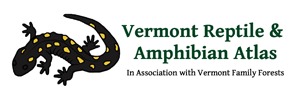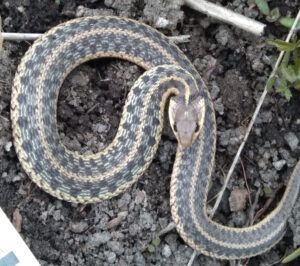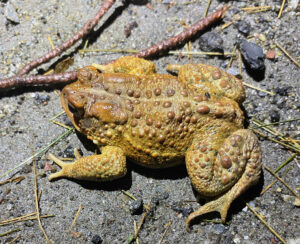Herp Update: Activity, Get Data, Radio — April 22, 2024
Recent Herp Activity
In much of Vermont, the warm and wet weather during the week of April 8-12 generated the bulk of our early-spring-amphibian migration. However, the warm, and dry weather over the past week has generated reports of Common Gartersnakes and Painted Turtles soaking up some sun in the lower and sunnier areas of the state.
Yesterday a friend and I made a trip to Stratton to find and check on a vernal pool. The pool was at an elevation of 2,200 ft. The road we used to access the area of the pool was not yet officially open for the season and we drove through muddy ruts and at times over a foot of packed snow to reach our destination. Once there, we hiked over patches of snow up to two-ft. deep and a beaver pond we passed was covered in a thin but solid layer of ice. The hike reminded me that even though my wife mowed some of our lawn here in Salisbury yesterday, there are still places in Vermont where migration of Wood Frogs and Spotted Salamanders is just beginning. Those areas are the higher elevations and shaded slopes. Also, keep in mind that even here in the lowlands, some heat-loving amphibians such as American Toads and Gray Treefrogs have barely started migrating at all.
Now is the Time to Document Pool Breeding Amphibians
In areas where the bulk of early spring amphibian migration is over, this is the ideal time to visit vernal pools and permanent ponds to check them for egg-masses and document the species that bred in them. For Wood Frogs and Jefferson Salamanders this opportunity will only last for a few weeks after the egg-masses are deposited. Their eggs will hatch and the masses will degenerate in a few weeks.
In contrast, you should be able to see Spotted Salamander egg-masses for an additional 4-6 weeks after Wood Frog egg masses have disappeared. This is partly because Spotted Salamanders deposit their masses later and over a longer period of time, but also because their egg-masses remain cohesive and visible for a couple weeks even after the eggs have hatched.
In all cases, now is the easiest time to document these species. All you need to do is take a few clear photos of an egg mass and send it to us.
Help us Fill in Data Gaps for Wood Frogs & Spotted Salamanders
Because the Vermont Herp Atlas started over 30 years ago, some of our records are now (or will soon be) over 25 years old. When that happens they become historic records, and we need to update them to prove that a given species is still found in a given town. We now have seven towns from which we need updated documentation for Wood Frogs. They are Baltimore, Bridgewater, Brunswick, East Haven, Irasburg, Maidstone, and Pittsford.
We need documentation of Spotted Salamanders from eleven towns. They have never been reported from Barre City, Isle La Motte, North Hero, Searsburg, St. Albans City, or Winooski.
Although Spotted Salamanders have been reported from the following five towns in the past, we now need updated photos from the towns of Dover, St. George, Westfield, Wheelock, and Whiting.
Any time you see an egg-mass of a Jefferson Salamander in any town, we would love a report and photo.
If you could visit a pond in any of the above towns and send us a couple photos of any egg masses you see, it would be a huge help. Even if you are not sure what species deposited the mass, we can figure it out from your photos.
You can find what’s needed in your town at our Data Gaps page.
If you would like to learn to identify the different types of egg-masses you should visit the Orianne Society’s Egg mass ID page at:
You could also watch our recorded presentation on Vernal Pool Reptiles and Amphibians at:
Call or e-mail Your Vt Herp Questions to VT Edition this Wednesday, April 24
This Wednesday from noon until 1 PM, I will be a guest on VPR’s Vermont Edition with host Mikaela Lefrak. We will be talking about Vermont herps and answering your questions.
VPR measures the interest of the public in a certain topic by the amount of e-mails and phone calls they receive prior to or during the show, so please do think of a couple questions and either call in at 1-800-639-2211 during the show or send an e-mail to: vermontedition@vermontpublic.org. We would love to hear from you.
Photos
The documentation photos we receive vary a lot in quality, which is fine. As long as we can recognize the species that is in the photo, the photo is good enough.
That said, some photos are excellent quality and some capture particular behaviors that we would like to share. Karlene Devine recently sent in the photo below of a Common Gartersnake in full defensive mode.
When they really feel threatened, gartersnakes will puff up with air, flatten out their jaws and coil as if to strike. When they puff up, in addition to looking larger, their pattern changes. The checkerboard pattern on their sides suddenly becomes visible (or more visible) and the white skin between their scales shows. When they flatten their jaws, they appear to have a triangular head and thin neck like a venomous snake. This must be at least occasionally successful in deterring predation or this activity would be useless for survival and we would not see it.
John Jose took this second photo. It shows a male American Toad that he found on the road in Montpelier on April 20. American Toads will become more active as the nighttime temperatures once again warm up.



